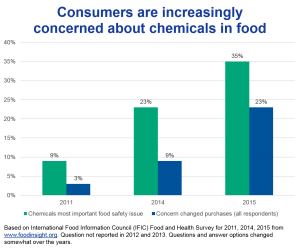Tom Neltner, J.D., is Chemicals Policy Director.
EDF strives to make safer food available by partnering with companies to reduce and eliminate potentially unsafe chemical food additives and supporting efforts to fix a broken regulatory system.
For many years this blog has focused on the safety of chemicals and nanomaterials used in industrial and consumer products. Most of these substances are regulated federally by the Environmental Protection Agency (EPA) under the Toxic Substances Control Act (TSCA). But we also encounter chemicals in other ways, including those present in or added to food. Such chemicals are regulated under a different law, the Federal Food, Drug and Cosmetics Act (FFDCA), administered by the Food and Drug Administration (FDA). This blog introduces EDF’s “Behind the Label” initiative to get unsafe and questionable chemicals out of our food by using dual levers of change—corporate leadersh ip and public policy. Making our food trustworthy demands leadership in both the private sector and the FDA.
ip and public policy. Making our food trustworthy demands leadership in both the private sector and the FDA.
The food market is changing rapidly as manufacturers work to keep up with consumer concerns about what’s in our food. And it’s not just about added sugar, salt and trans fats, or whether the food was grown locally or with or without pesticides. Public campaigns increasingly put the spotlight on many chemicals commonly used in food and food packaging—food additives—with growing scientific evidence questioning the safety of their use.
A respected industry survey released in May 2015 showed that 36% of consumers rated chemicals in food as their most important food safety concern – greater than pathogens, pesticides, animal antibiotics and allergens, and up from 23% in 2014 and 9% in 2011. These concerns translated into action; 23% of consumers reported changing their buying habits (corrected from 45% on May 16, 2016).
A CivicScience survey released the same month showed similar results, with those having concerns more likely to live in rural areas, not use social media, and make their lunch rather than going out to eat—suggesting that this is not just about the latest trend among ‘foodies’.
In 2015, major food companies such as Nestle, General Mills, Kellogg’s, Hershey’s and Campbell’s announced commitments to reformulate many of their iconic brands to be free of artificial colors and flavors. National restaurant chains such as Panera, Pizza Hut, Taco Bell, Subway and Noodles & Company also made similar commitments. They are following the lead of grocers such as Whole Foods, Trader Joe’s, Kroger and ALDI who have reformulated some of their private brands. Tens of billions of dollars of products are being reformulated. And that’s a good thing.
These commitments are only one step in addressing the much larger problem of potentially unsafe chemicals present in food and their cumulative effect on our health. After years of research, in 2013, The Pew Charitable Trusts concluded that the regulatory system is “plagued with systemic problems.”
The key problem dates back to the 1958 amendment to the FFDCA, which provided an exemption for substances “generally recognized as safe” (GRAS) – an exemption that has been stretched so far it has swallowed the law. Today, an estimated 1,000 chemicals have been designated as GRAS by additive and food manufacturers without review by or even notice to FDA, the agency charged with ensuring that our food is safe and improves public health. Pew’s analysis confirmed the Government Accountability Office’s conclusion in 2010 that “FDA’s oversight process does not help ensure the safety of all new GRAS determinations.”
Among Pew’s findings:
- “Conflicts of interest. Food manufacturers make GRAS safety decisions without FDA’s knowledge despite conflicts of interest among those making the determinations. The GRAS loophole as currently used is inconsistent with Congress’ plan and the practices of other developed countries.”
- “Lack of information. FDA lacks even basic information needed to assess the safety of thousands of chemicals that” the agency has reviewed and either approved or cleared for use in food. Even when the information is developed, “the agency reevaluates the safety of only a relative handful of existing additives.”
- “Outdated science. FDA uses outdated science to evaluate additive safety. It relies on a process that does not ensure independent scientific input and is often not transparent, particularly for food contact substances.”
In 2014, FDA’s deputy commissioner for food said “we simply do not have the information to vouch for the safety of many of these chemicals.” Reports and videos from the Natural Resources Defense Council (NRDC), Center for Science in the Public Interest, Center for Public Integrity and WebMD have also documented and publicly highlighted the problem with the GRAS loophole.
Systemic problems demand systemic solutions based on the latest science. This means going beyond a game of whack-a-mole—where companies react to the latest concerns by replacing one problematic additive with another that is no safer or no better understood—to adopt a forward-looking approach that promotes market competition for the safest ingredients while strengthening regulatory and scientific standards.
In the coming weeks and months, we’ll be outlining the problem of untested and questionable chemicals in food, our failed public policies, the current state of the market response to rising concerns, and our vision for leadership in ensuring the safety of chemicals in food and food packaging. Stay tuned.









